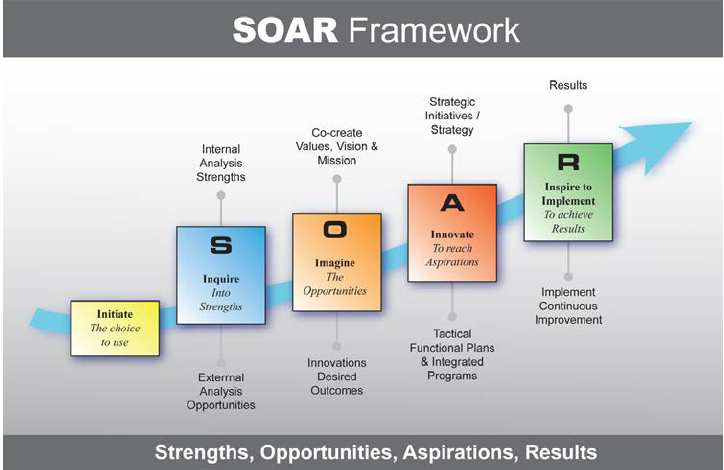 Frequently I tell people (including the grad students I teach) that strategy can be done well in many different ways. Certainly, I prefer the Mission Impact approach, but there are a lot of great methodologies out there that can work for organizations.
Frequently I tell people (including the grad students I teach) that strategy can be done well in many different ways. Certainly, I prefer the Mission Impact approach, but there are a lot of great methodologies out there that can work for organizations.
One interesting approach is S.O.A.R., which you can read more about it at this link. S.O.A.R. stands for Strengths, Opportunities, Aspirations, Results. In this model, stakeholders are engaged to identify Strengths and Opportunities which then lead to the creation of Aspirations and desired Results.
S.O.A.R. which has its basis in Appreciative Inquiry, which is defined by the S.O.A.R. authors as “a philosophy and organizational change approach that builds on strengths and what is called the life-giving forces of the organization’s existence, its positive core.”*
While they do not include Weaknesses and Threats in their acronym, they are not left out. The authors add: “Weaknesses and threats are not ignored. They are reframed and given the appropriate focus within the opportunities and results conversations. Ultimately it becomes a question of balance. Why not spend as much time or more on what you do well and how you can strengthen a strategic advantage? What gives you more energy to take action? What gives you confidence to set a stretch goal and achieve results?”*
S.O.A.R. leverages a 5-I Approach which asks the following questions:
Initiate: How shall we work together?
Inquire: What are our strengths and opportunities?
Imagine: What can we aspire to?
Innovate: What can we create to achieve our aspirations?
Inspire to Implement: How do we move forward to achieve our goals?
Answering these questions then provides a roadmap forward for the organization to implement its strategy. If you like this basic description then think about ordering the book (it’s a quick read) and SOAR on to enhanced Mission Impact!
*Stavros, J.M. & G. Hinrichs. The Thin Book of SOAR, Thin Book Publishing, Bend, OR, 2009.